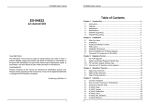Download Manual - TopsCCC
Transcript
EX98354 User’s manual EX-98354 User’s manual Table of Contents EX-98354 Chapter 1 Introduction......................................................................................4 Multi-functions Counter / Timer Card User’s Guide 1.1 1.2 1.3 1.4 1.5 1.6 Introduction ................................................................................................4 Features ....................................................................................................5 Applications ...............................................................................................5 Specifications.............................................................................................6 Software Supporting ..................................................................................7 Programming Library .................................................................................7 Chapter 2 Installation........................................................................................8 2.1 2.2 2.3 2.4 2.5 2.6 2.7 2.8 What You Have ..........................................................................................8 Unpacking..................................................................................................8 Hardware Installation Outline .....................................................................8 PCB Layout................................................................................................9 Installation Procedures ..............................................................................10 Device Installation for Windows Systems ..................................................10 Connector Pin Assignment of EX-98354....................................................11 Card number setting ..................................................................................13 Chapter 3 Registers Format .............................................................................14 Copy Right Notice The information in this manual is subject to change without prior notice in order t o improve reliability, design and function and does not represent a commitment on the part of the manufacturer. No part of this manual may be reproduced, copied, or transmitted in any form without the prior written permission of manufacturer. 3.1 3.2 3.3 3.4 PCI PnP Registers.....................................................................................14 PCI controller register address map ..........................................................15 Timer/counter register................................................................................16 Digital Input/Output Register Address Map ................................................19 Chapter 4 Operation Theorem..........................................................................20 Acknowledgment Products mentioned in this manual are mentioned for identification purpose only. Products manes appearing in this manual may or may not be registered trademarks or copyright of their respective companies Printed Sep. 2002 Rev 1.0 4.1 4.2 4.3 4.3.1 4.3.2 4.4 4.5 4.6 4.7 4.8 Clock System.............................................................................................20 Counters architecture ................................................................................20 Clock Source Configurations .....................................................................21 Independent Counters (Counter #1~#10) ..................................................21 Cascaded counters (Counter #11~#12) .....................................................22 Gate control configurations ........................................................................23 Counter outputs .........................................................................................23 Interrupt System ........................................................................................23 Digital debounce ........................................................................................24 Digital Input and output ..............................................................................25 Chapter 5 Libraries............................................................................................26 5.1 1 2 Libraries Installation ...................................................................................26 How to use the Functions in PCIDAQ.DLL................................................ 26 Summary of function calls ......................................................................... 27 W_8354_Open.......................................................................................... 28 W_8354_GetCardsID................................................................................ 29 W_8354_Version....................................................................................... 30 W_8354_GetBusSlot ................................................................................ 31 W_8354_Close ......................................................................................... 32 W_8354_Read_Di..................................................................................... 33 W_8354_Write_Do.................................................................................... 34 W_8354_Set_Do_Bit................................................................................. 35 W_8354_Reset_Do_Bit............................................................................. 36 D_8354_Set_Counter ............................................................................... 37 W_8354_Set_CLKSource ......................................................................... 38 W_8354_Write_Counter............................................................................ 39 W_8354_Read_Counter ........................................................................... 40 W_8354_Stop_Counter............................................................................. 41 W_8354_Set_CK1 .................................................................................... 42 W_8354_Set_DebounceCLK .................................................................... 43 W_8354_Set_DebounceMode .................................................................. 44 D_8354_Read_IntStatus ........................................................................... 45 W_8354_Clear_IntStatus .......................................................................... 46 W_8354_IntEnable ................................................................................... 47 W_8354_IntDisable................................................................................... 48 Chapter 1 Introduction 1.1 Introduction EX-98354 is a general-purpose counter / timer and digital I/O card. This card have four 8254 chips on board, so it provides twelve 16 bits down counter or frequency dividers. This card has multi-configurations. The counters can be set as independent counter or cascaded counter. The gate control of counter comes from either external source or internal default enable signal. The clock source of the counters can be set as internal or external clock source, user can set the jumper to decide whether the debounce function is used or not used. It is possible to use this card on variety of powerful counter / timer functions to match your industry and laboratory applications. The card also provides digital output and input port. There are 8 bits digital output and 8 bits digital input channels that can be used to control or monitor the external devices. EX-98354 provides one interrupt signal that comes from internal or external interrupt sources. The interrupt can be used for watchdog timer or others applications. The maximum interrupt time interval can be 536 sec. Chapter 6 EX-9837 Terminal board.................................................................. 49 16 digital input/output 16 IN 16 OUT ECLK1 ~ ECLK3 Chip #1 GATE1 ~ GATE3 COUT1 ~ COUT3 ECLK4~ ECLK6 PCI BUS Data Address INT #A PCI controller Chip #2 GATE4 ~ GATE6 COUT4 ~ COUT6 ECLK7 ~ ECLK9 Chip #3 Interrupt control GATE7 ~ GATE9 COUT7 ~ COUT9 COUT10 ~ COUT11 Chip #4 COUT12 ECLK10 ECLK1 ~ ECLK10 Block diagram of the EX-98354 3 4 37-pin D-type connector (CN3) 5.2 5.3 5.4 5.5 5.6 5.7 5.8 5.9 5.10 5.11 5.12 5.13 5.14 5.15 5.16 5.17 5.18 5.19 5.20 5.21 5.22 5.23 5.24 EX-98354 User’s manual 40-pin FRC (CN2) EX98354 User’s manual EX98354 User’s manual 1.2 EX-98354 User’s manual 1.4 Features Programmable Counter / Timer Multi-configurations of counters / timers Device: 82C54x4 Flexible setting for each independent counter, the clock source Number of Counters /timers: 10 independent timers / counters cascaded 32-bit counters with fixed 8MHz internal clock Could be external, internal or cascaded. The gate signal is external controlled or internal enabled. Counter mode: 16-bit down counter Maximum input frequency: 10MHz Provide debounce function with flexible setting to prevent from bounce phenomenon when using external clock. Clock sources of independent counters: 8 digital output channels External clock 8 digital input channels Prior counter output Interrupt source comes from output of counter #12 or external source. CK1 (Programmable) 37−pin D-type female connector. Clock #10 output Board card number 1.3 Specifications Four 8254 chips provide twelve 16 bits down counters CK1 clock sources: (Programmable) Applications 8MHz internal base clock Laboratory and Industrial automation Programmable counter 11 output Event counter Gate control: default enable or external control Frequency generator Digital Filter Circuits Frequency synthesizer De-bounce clock: (Programmable) Pulse width measurement 8MHz internal base clock Testing & Measurement Programmable counter #11 output Laboratory & Education Digital I/O (DIO) Input channels: 16 channels Output channels: 16 channels (dedicated output) Electronics characteristics: TTL compatible signal Environmental: Power requirements: +5V 350mA (typical) Operation Temp: 0 to 50C˚ Storage Temp: -20 to 70C˚ Humidity: 0 to 90% none-condensing Dimensions: 180 mm x 105 mm 5 6 EX98354 User’s manual 1.5 EX-98354 User’s manual Software Supporting Chapter 2 Topsccc provides versatile software drivers and packages for users’ different approach to built-up a system. We not only provide programming library such as DLL for many Windows systems, but also provide drivers for many software package such as LabVIEW™ ,Intouch™ and so on. All the software options are included in the provided CD. 1.6 Programming Library The provided CD includes the function libraries for many different operating systems, including: Installation This chapter describes how to install the EX-98354 card. Please follow the follow steps to install the EX-98354 card. 2.1 What You Have In addition to this User's Manual, the package includes the following items: DOS Library: Borland C/C++ and Microsoft C++, the functions descriptions are included in this user’s guide. EX-98354 board Windows 98/2000/NT/Me/XP DLL: For VB, VC++, BC5, the functions Descriptions are included in this user’s guide. This user’s manual Driver/utilities CD If any of these items is missing or damaged, contact the dealer from whom you purchased the product. Save the shipping materials and carton in case you want to ship or store the product in the future Windows 98/2000/NT/Me/XP ActiveX: For Windows’s applications LabVIEW ® Driver: Contains the VIs, which are used to interface with NI’s LabVIEW ® software package. Supporting Windows 95/98/NT/2000. The LabVIEW ® drivers are free shipped with the board. 2.2 Unpacking Your EX-98354 card contains sensitive electronic components that can be easily damaged by static electricity. The operator should be wearing an anti-static wristband, grounded at the same point as the anti-static mat. Inspect the card module carton for obvious damage. Shipping and handling may cause damage to your module. Be sure there are no shipping and handing damages on the module before processing. InTouch Driver: Contains the InTouch driver which support the Windows 98/2000/NT/XP. The The InTouch ® drivers are free shipped with the board. After opening the card module carton, extract the system module and place it only on a grounded anti-static surface component side up. Again inspect the module for damage. Press down on all the socketed IC's to make sure that they are properly seated. Do this only with the module place on a firm flat surface. 2.3 Hardware Installation Outline PCI configuration The PCI cards are equipped with plug and play PCI controller, it can request base addresses and interrupt according to PCI standard. The system BIOS will install the system resource based on the PCI cards’ configuration registers and system parameters (which are set by system BIOS). Interrupt assignment and memory usage (I/O port locations) of the PCI cards can be assigned by system BIOS only. These system resource assignments are done on a board-by-board basis. It is not suggested to assign the system resource by any other methods. PCI slot selection The PCI card can be inserted to any PCI slot without any configuration for system resource. 7 8 EX98354 User’s manual 2.4 PCB Layout EX-98354 User’s manual 2.5 Installation Procedures 1. Turn off your computer. 2. 150 mm 3. 8254 8254 102 mm 8254 5. 2 8254 4. NO USED 1 OSC CN1 CN2 CN3 Remove the cover from your computer. Setup jumpers on the card. Before handling the PCI cards, discharge any static buildup on your body by touching the metal case of the computer. Hold the edge and do not touch the components. 6. Position the board into the PCI slot you selected. 7. Secure the card in place at the rear panel of the system. 2.6 Device Installation for Windows Systems Once Windows 95/98/2000 has started, the Plug and Play function of Windows system will find the new Expert cards. If this is the first time to install Expert cards in your Windows system, you will be informed to input the device information source. 40 PCI Bus Controller 39 ID 1 2 3 4 J P1 CPLD Turn off all accessories (printer, modem, monitor, etc.) connected to your computer. CN3: Timer/counter channel #1 ~ channel #12 CN: Digital input (DI_0 ~ DI_15) and digital output (DO_0 ~ DO_15) CN1: Reserved for testing only JP1: Card number jumper 9 10 EX98354 User’s manual 2.7 EX-98354 User’s manual The CN2 pin assignment is as shown in Figure 2-2 Connector Pin Assignment of EX-98354 The CN2 is a 40-pin FRC connector and can be converted to 37-pin D-type connector by using converting cable attached in the package. There are two connectors labeled “CN2” and “CN3”. The CN3 connector is a 37-pin D-type connector and CN2 connector is a 40-pin FRC connector. The pin assignment of the CN2 (40-pin FRC connector) includes 16 digital input and output signals The pin assignment of the CN3 (37-pins D-type connector) includes 12 timer/counter input and output signals The CN3 pin assignment is as shown in Figure 2-1 CN3 ECLK_1 GAET_1 COUT_1 ECLK_2 GAET_2 COUT_2 ECLK_3 GAET_3 COUT_3 ECLK_4 GAET_4 COUT_4 ECLK_5 GAET_5 COUT_5 ECLK_6 GAET_6 COUT_6 ECLK_7 1 20 2 21 3 COUT_7 22 ECLK_8 23 GAET_8 24 COUT_8 4 5 6 25 ECLK_9 26 GAET_9 7 8 1 DI_1 2 DI_2 3 DI_3 4 DI_4 5 DI_5 6 DI_6 7 DI_7 8 DI_8 9 DI_9 10 27 COUT_9 DI_10 11 28 ECLK_10 DI_11 12 DI_12 13 DI_13 14 COUT_11 DI_14 15 COUT_12 DI_15 16 GND 17 DO_0 18 DO_1 19 9 10 29 11 30 12 31 13 32 14 GAET_10 COUT_10 33 GND 34 GND 15 16 35 GND 36 +5V 37 +5V 17 18 19 GAET_7 DI_0 20 DO_2 21 DO_3 22 DO_4 CN2 23 DO_5 24 DO_6 25 DO_7 26 DO_8 27 DO_9 28 DO_10 29 DO_11 30 DO_12 31 DO_13 32 DO_14 33 DO_15 34 GND 35 GND 36 +5V 37 +5V Converting cable DI_0 DI_1 DI_2 DI_3 DI_4 DI_5 DI_6 DI_7 DI_8 DI_9 DI_10 DI_11 DI_12 DI_13 DI_14 DI_15 GND DO_0 DO_1 1 3 5 7 9 11 13 15 17 19 21 23 25 27 29 31 33 35 37 39 2 4 6 8 10 12 14 16 18 20 22 24 26 28 30 32 34 36 38 40 40-pin FRC connector Figure 2-2 Pin Assignment of EX-98354 connector CN2 Legend: Figure 2-1 Pin Assignment of EX-98354 connector CN3 DO_n: Digital output channel #n (n= 0 ~ 15) DI_n: Digital input channels #n (n= 0 ~ 15) Legend: GND: Ground return path of digital input/output channels ECLK_n: Clock input channel #n(n= 1 ~ 10) +5V: Non-isolated +5V DC output GATE_n: Gate control input channel #n (n=1 ~ 10) COUT_n: Count output channel #n (n=1 ~ 12) :GND: Ground return path of counter/time channels +5V: Non-isolated +5V DC output 11 12 DO_2 DO_3 DO_4 DO_5 DO_6 DO_7 DO_8 DO_9 DO_10 DO_11 DO_12 DO_13 DO_14 DO_15 GND GND +5V +5V EX98354 User’s manual 2.8 EX-98354 User’s manual Card number setting Chapter 3 Maximum four EX-98354 cards can be installed in system simultaneously with each has a unique card number. Registers Format Card number 1 (default setting) 1 2 3 4 1 2 3 4 1 2 3 4 JP1 1 2 3 4 A jumper called “JP1” (see page 9) on the card is used to set the card number starts from 1 to 4 This information is quite useful for the programmers who wish to handle the card by low-level programming. However, we suggest user have to understand more about the PCI interface then start any low-level programming. In addition, the contents of this chapter can help users understand how to use software driver to manipulate this card. 3.1 PCI PnP Registers There are two types of registers: PCI Configuration Registers (PCR) and Peripheral Interface Bus (PIB). The PCR, which is compliant to the PCI-bus specifications, is initialized and controlled by the plug & play (PnP) PCI BIOS.. 2 The PCI bus controller Tiger 100/320 is provided by Tigerjet Network Inc. (www.tjnet.com). For more detailed information of PIB, please visit Tigerjet technology’s web site to download relative information. It is not necessary for users to understand the details of the PIB if you use the software library. The PCI PnP BIOS assigns the base address of the PIB. The assigned address is located at offset 14h of PIB . 3 4 The 94264 board registers are in 32-bit width. But only lowest byte (bit0~bit7) is used. The users can access these registers by only 32-bit I/O or 8-bit I/O instructions. The following sections show the address map, including descriptions and their offset addresses relative to the base address. 13 14 EX98354 User’s manual 3.2 EX-98354 User’s manual 3.3 PCI controller register address map Timer/counter register Reset control register Timer/counter registers The EX-98354 is in inactive state when the system power on, and should be activated by set bit o of this register to “1” state Address: Base + 0C0H~0FCH and AUX0=1 Address: Base + 0x00h Attribute: Write/read Attribute: Write only Value: (Write 01H to Base+03H before accessing Base + 0C0H~0FCH ports) Value: 01 PCI Internal special control register Port address AUX0 Function EX-98354 internal control register, should be written with value 01H before controlling EX-98354 card Base+0C0H 1 Counter 1 Register (R/W) Address: Base + 002h Base+0C4H 1 Counter 2 Register (R/W) Attribute: Write only Base+0C8H 1 Counter3 Register (R/W) Value: always are 01h Base+0CCH 1 Mode Control Register (W) Read Back Register (R) Base+0D0H 1 Counter4 Register (R/W) Base+0D4H 1 Counter 5 Register (R/W) Attribute: Write only Base+0D8H 1 Counter 6 Register (R/W) Value: 10H =enable PCI INT A# Base+0DCH 1 Mode Control Register (W) Read Back Register (R) Base+0E0H 1 Counter 7 Register (R/W) Base+0E4H 1 Counter 8 Register ( R/W) Base+0E8H 1 Counter 9 Register (R/W) Attribute: Write only Base+0ECH 1 Mode Control Register (W) Read Back Register (R) Value: 00H =enable Timer/counter port decoder (AUX0=0) Base+0F0H 1 Counter 10 Register (R/W) Base+0F4H 1 Counter 11 Register (R/W) Base+0F8H 1 Counter 12 Register (R/W) Base+0FCH 1 Mode Control Register (W) Read Back Register (R) Interrupt mask control register Enable or disable PCI interrupt INT #A Address: Base + 0x05h 00H=disable PCI INT #A PCI controller internal Aux port data (AUX0~AUX7) register Enable/disable Timer/counter or Digital I/O port address decoder Address: Base + 0x03h 01H=enable Digital I/O port decoder (AUX0=1) 15 16 EX98354 User’s manual EX-98354 User’s manual Timer CLK source /Interrupt mode control registers Interrupt status register There are total twenty-two bits on EX-98354 to select clock source of Timer / Counter #1 ~ #10 and CK1 and debounce clock and interrupt source. Read interrupt status (Timer #12 COUT_12 and/or digital input DI_0) Address: Base + 0DCH and AUX=0 Address: Base + 0F0H~0F8H and AUX=0 (Write 00H to Base+03H before accessing Base + 0DCH port) (Write 00H to Base+03H before accessing Base + 0F0H~0F8H ports) Attribute: Read only Attribute: Write/read Value: Bit no. Base + 0F0H and AUX=0 (timer #1~time #4 CLK source register) Bit no. Timer/counter 1,0 3,2 5,4 7,6 Timer #1 CLK(CLK_1) Timer #2 CLK(CLK_2) Timer #3 CLK(CLK_3) Timer #4 CLK(CLK_4) 0,0 ECLK_1 ECLK_2 ECLK_3 ECLK_4 Bit value 0,1 1,0 GND CK1 COUT_1 CK1 COUT_2 CK1 COUT_3 CK1 0 1 2 3 4 5 1,1 COUT_10 COUT_10 COUT_10 COUT_10 Interrupt source Digital input DI_0 Timer #12 COUT_12 xx xx xx xx Interrupt status Interrupt 1 1 xx xx xx xx No interrupt 0 0 xx xx xx xx Debounce control registers Base + 0F4H and AUX=0 (timer #5~time #8 CLK source register) Bit no. Timer/counter 1,0 3,2 5,4 7,6 Timer #5 CLK(CLK_5) Timer #6 CLK(CLK_6) Timer #7 CLK(CLK_7) Timer #8 CLK(CLK_8) 0,0 ECLK_5 ECLK_6 ECLK_7 ECLK_8 Bit value 0,1 1,0 COUT_5 CK1 COUT_6 CK1 COUT_7 CK1 COUT_8 CK1 There are total eleven bits on EX-98354 to enable or disable debounce function clock source of Timer / Counter #1 ~ #10 and DI_0 Address: Base + 0D0H ~ Base + 0D4H and AUX=0 (Write 00H to Base+03H before accessing Base +0D0H and Base+0D4H ports) 1,1 COUT_10 COUT_10 COUT_10 COUT_10 Attribute: Write only Value: Base + 0D0H and AUX=0 (timer #1~time #8 CLK debounce register) Base + 0F8H and AUX=0 (timer #9~time #10CLK source and debouce time and interrupt mode control registers) Bit Timer/counter no. 1,0 Timer #9 CLK(CLK_9) 3,2 Timer #19 CLK(CLK_10) 4 CK1 source 5 DI_0 interrupt 6 Debounce time 7 COUT_12 interrupt Bit value 0,0 0,1 1,0 ECLK_5 COUT_5 CK1 ECLK_6 COUT_6 CK1 =08M OSC =0Disable =02 usec =0Disable Bit no. Timer ECLK debounce 0 1 2 3 4 5 6 7 1,1 COUT_10 COUT_10 =1COUT11 =1Enable =1 COUT11x4 =1Enable 17 18 Timer #1 ECLK_1 Timer #2 ECLK_2 Timer #3 ECLK_3 Timer #4 ECLK_4 Timer #5 ECLK_5 Timer #6 ECLK_6 Timer #7 ECLK_7 Timer #8 ECLK_8 Bit value Disable Enable 0 1 0 1 0 1 0 1 0 1 0 1 0 1 0 1 EX98354 User’s manual EX-98354 User’s manual Base + 0D4H and AUX=0 (timer #9~time #10 CLK and DI_0 debounce register) Bit no. Timer ECLK debounce 0 1 2 3 4 5 6 7 3.4 Chapter 4 Operation Theorem Bit value Disable Enable 0 0 0 xx xx xx xx xx 1 1 1 xx xx xx xx xx Timer #9 ECLK_9 Timer #10 ECLK_10 Digital input DI_0 xx xx xx xx xx 4.1 Clock System The clock of counter / timer #1 ~ #10 can be one of the 4 sources: external clock source or cascaded source from the ‘last’ channel or CK1 (8MHz OSC or COUT11) or COUT10. The clock of counter / timer #11 is fixed at 8Mhz, and clock of counter / timer #12 is connected to COUT11 4.2 Counters architecture There are four 8254 chips on EX-98354 card. Counter #1~ #10 can be programming to independent or cascaded counters and counters #11and #12 are cascaded counters. There are three signals (2 input, 1 output) for each counter, a clock input signal, a gate control signal, and an output signal. CLK1 ~ CLK12 are clock sources and GATE1 ~ GATE12 are gate control signals. The COUT1 ~ COUT12 are output of the counters. The Figure 5-3 shows all the labels and the inter-connection of the 8254 counters. Digital Input/Output Register Address Map There are 16 TTL digital inputs and 16 outputs on EX-98354; each bit of based address is corresponding to a signal on the digital input or output channel. Address: Base+0C0H~0CCH and AUX=0 Attribute: Base+0C0H~Base+0C4H read only Base+0C8H~Base+0CCH write only, Chip #1 Value: Base+0C0H =Digital input port #0 (DI_0 ~DI_7), read only Base+0C4H =Digital input port #1 (DI_8~DI_15), read only Base+0C8H =Digital output port #0 (DO_0 ~DO_7), write only Base+0CCH =Digital output port #1 (DO_8~DO_15), write only Chip #3 Counter #1 CLK1 GATE1 COUT1 Counter #1 CLK7 GATE7 COUT7 Counter #2 CLK2 GATE2 COUT2 Counter #2 CLK8 GATE8 COUT8 Counter #3 CLK3 GATE3 COUT3 Counter #3 CLK9 GATE9 COUT9 Chip #4 Chip #2 Counter #1 CLK4 GATE4 COUT4 Counter #1 Counter #2 CLK5 GATE5 COUT5 Counter #2 Counter #3 CLK6 GATE6 COUT6 Counter #3 Figure 5-3 Counters architectural 19 20 CLK10 GATE10 COUT10 CLK11 GATE11 COUT11 CLK12 GATE12 8MHz "H" "H" COUT12 EX98354 User’s manual 4.3 EX-98354 User’s manual 4.3.2 Clock Source Configurations The counter #1~ #10 can be programming to independent or cascaded counters and the clock source of each counter can be ECLK #n (external CLK input), COUT #n-1 (Previous counter output), CK1 (8MHz or COUT #11) or 8M OSC(Fixed 8MHz) by using function (W_8354_SetCntlCLK and "W_8354_SetCK1) 4.3.1 Cascaded counters (Counter #11~#12) The connection of Counter #11 and #12 are different from other independent counters. These two counters are named as cascaded counters. The clock source fo counter #11 comes from fixed 8 MHz and its output are cascaded to counter #12. In fact, counter #11and #12 are designed for frequency divider by using 8254's square wave generator mode. The gates of these counters always keep at 'H' level for enabling counters all the time. Independent Counters (Counter #1~#10) For Timer/counter #1 +5V ECLK #1 8M OSC GND CK1 COUT #11 CLK 1 Counter 1 GATE #1 CLK 11 8M OSC COUT #1 8M OSC CLK 12 Counter 11 Counter 12 GATE #11 COUT #11 GATE #12 COUT #12 For Timer/counter #2~#9 N= #2~ #9 ECLK #n 8M OSC CK1 COUT #11 COUT #n-1 CLK #n Counter #n GATE #n Note: COUT #n 1. That the signals COUT #12 can also be used as interrupt source. See page 2. Although there is one set cascaded counter on board, users may need more cascaded counters. User can set the clock source of every independent counter by program. Therefore, the independent counter output can be cascaded to the next counter's clock source to implement cascaded counter. 3. An example of ‘user programmable cascaded counters (counter #1 and counter #2) as shown in Figure 4-4 COUT #10 For Timer/counter #10 ECLK #10 8M OSC COUT #11 CK1 COUT #9 CLK 10 Counter 10 GATE #10 COUT #10 8M OSC Note: If counter #1 is set to cascaded mode, CLK1 is connected to GND because COUT #0 doesn’t exist. ) ECLK #1 8M OSC CK1 COUT #11 GND CLK 1 8M OSC ECLK #2 COUT #1 COUT #10 Figure 4-4 22 GATE #1 COUT #1 N= #2~ #9 CLK #2 CK1 21 Counter 1 Counter 2 GATE #2 COUT #2 EX98354 User’s manual 4.4 EX-98354 User’s manual 4.7 Gate control configurations Digital debounce Debounce system is used to eliminate bounce phenomenon. If external clock is used, user can select if debounce system is used or not used by software. If debounce system is used, the debounce output signal will be the same state as the input only if the input signal keep the same state for four debounce clocks, otherwise the input signal will be treated as glitch and the debounce output signal will keep previous state, The gate control signals of the counters are internally pulled high hence they are default enable if no external gate used. +5V n=1~12 10K Counter #n Gate #n Disable Debounce ECLK0~ECLK10 or DI_0 4.5 Counter outputs Read IN The all timer / counter output signals (COUT_ n) of 8254 are sent to the 37-pin D-type connector directly, please see 'Pin assignment' for corresponding signal pin number. Noise In addition, the output signal may be used as clock source for cascaded counters, see the above sections. It is possible to cascaded ten counters by software setting, Enable Debounce Noise ECLK0~ECLK10 or DI_0 The counters output COUT12 is also used as internal interrupt source 4.6 Signal Interrupt System Read IN The EX-98354 is a Dual Interrupt System. The dual interrupt(DI_0 and COUT_12) means the hardware can generate two interrupt request signals at the same time and the software can service these two request signals by Interrupt Status Register Debounce Rising edge Interrupt from DI_0 and/or COUT_12 DI_0 or COUT_12 The following is a functional description of the digital debounce. 1. INT 2. Generate Interrupt 3. Note: There is only one IRQ level used by this card. This card uses INT #A interrupt request signal to PCI bus that means the DI_0 and COUT_12 use the same interrupt level. 23 24 When a digital debounce is enabled, the EX-98354 will sample the signals at the enabled input channel at a 8usec (or COUT_12*4) sampling rate. When a high or low signal is present at a digital input channel whose digital debounce function is enabled, the signal will be filtered out as noise unless it lasts for an effective period. Effective period = 8 usec (or COUT_12 period*4) EX98354 User’s manual 4.8 EX-98354 User’s manual Digital Input and output Chapter 5 Each digital input or output (DI_0~DI_15 and DO_0~DO_15) is a TTL structure. The input /output voltage range form 0V to 5V and input pull-up resister is 10K ohms for all digital inputs. The connection between outside signal and EX-98354 digital inputs is shown in Fig Figure 4-5. Libraries This chapter describes the software library for operating this card. Only the functions in DOS library and Windows 98/2000 DLL are described. Please refer to the PCIDAQ function reference manual, which included in Topsccc CD for the descriptions of the Windows 98/NT/2000 DLL functions. (All the digital outputs can be read back by the same I/O address) +5V 5.1 Digital voltage input Libraries Installation The device drivers and DLL functions of Windows 98/NT/2000 are included in the PCIDAQ. The Topsccc CD also includes the detail examples and readme files 10K DIO_n (0~15) + V 0 ~5V - 5.2 How to use the Functions in PCIDAQ.DLL VC++6.0: GND 1. Add file '../Include/PCIDAQ.H' in your project 2. In link page of menu project| setting, add '../LIB/PCIDAQ.LIB' in the blank of Objects/Library Modules +5V Digital dry input 3. 10K DIO_n (0~15) Add this sentence "#include '../Include/PCIDAQ.H' " to the head of your main file. Visual BASIC: 1. GND Add file '../Include/Declare.bas' in your project. Delphi : 1. 2. +5V Add file '../Include/Declare.pas' in your project Add this sentence "uses Declare;" in the head of your unit.pas C++Builder: Digital output 1. 10K DIO_n (0~15) 2. Add file '../Include/PCIDAQ.H' and '../Lib/PCIDAQ_CB.lib' to your project Add this sentence "#include '../Include/PCIDAQ.H' " to head of your main file. Loading GND Note: For more information, please refer to program in directory '../Example/' Figure 4-5 25 26 EX98354 User’s manual 5.3 EX-98354 User’s manual 5.4 Summary of function calls W_8354_Open Description: Function Description Initial EX-98354 card before using other functions W_8354_GetCardsID Get EX-98354 card number W_8354_Version Get version number of PCIDAQ.DLL Get PCI bus and slot number occupied W_8354_GetBusSlot by EX-98354 Close EX-98354 card before terminating W_8354_Close program W_8354_Read_Di Read digital input port data (8-bit) W_8354_Write_Do Write data (8-bit) to digital output port W_8354_Set_Do_Bit Set a bit of port to high W_8354_Reset_Do_Bit Reset a bit of port to low D_8354_Set_Counter Initial timer/counter W_8354_Set_CLKSource Select timer/counter clock source Write timer/counter work mode and W_8354_Write_Counter value Read timer/counter work mode and W_8354_Read_Counter value W_8354_Stop_Counter Stop timer/counter W_8354_Set_CK1 Select CK1 clock source W_8354_Set_DebounceCLK Set debounce clock source W_8354_Set_DebounceMode Set debounce mode D_8354_Read_IntStatus Read interrupt status register (DOS only) W_8354_Clear_IntStatus Clear interrupt status register W_8354_IntEnable Enable digital input change interrupt W_8354_IntDisable Disable digital input interrupt W_8354_Open Because the EX-98354 is PCI bus architecture and meets the plug and play design, the IRQ and base_address (pass-through address) are assigned by system BIOS directly. EX-98354 cards have to be initialized by this function before calling other functions. Page 28 29 30 Syntax: C/C++ (DOS) 31 WORD D_8354_Open (WORD cardNo); 32 C/C++ (Windows) 33 34 35 36 37 38 WORD D_8354_Open (WORD *ExistCards); Visual BASIC (Windows) W_8354_Open (ByRef ExitedCards As Long) As Long Delphi W_8354_Open (var ExistedCards:Integer): Integer; Argument: 39 CardNo: card number (1,2,3,4) (for DOS only) existCards: The number of installed EX-98354 cards. (for Windows only) 40 This returned value shows how many EX-98354 cards are installed in your system. 41 42 43 44 45 46 47 48 Return Code: Error code (Please refer to PCIDAQ.H or DOSDAQ.H) 27 28 EX98354 User’s manual 5.5 EX-98354 User’s manual 5.6 W_8354_GetCardsID Description: W_8354_Version Description: Get the cards number that is set by jumper on cards. PCIDAQ.DLL driver drives the EX-98354 cards. This function returns the version of PCIDAQ.DLL driver Syntax: Syntax: C/C++(DOS) void D_8354_GetCardsID(WORD *CardsIDArray); C/C++ (DOS) C/C++(Windows) void D_8354_Version (char *version) WORD W_8354_GetCardsID (WORD *CardsIDArray); C/C++ (Windows) Visual BASIC (Windows) WORD D_8354_Version (void) Visual BASIC (Windows) Function W_8354_GetCardsID (ByRef CardsIDArray As Long) As Integer Function W_8354_Version () As Long Delphi Delphi Function W_8354_GetCardsID (var CardsIDArray:Word):Word; Function W_8354_Version ():Integer Argument: Argument: CardsIDArray: This array return card number (1,2,3,4), which is set by jumper on the card. You should define a 4 elements array, then pass the array's pointer to this function. version: return the PCIDAQ.DLL driver version string (DOS only) Return Code: The version of PCIDAQ.DLL in integer data format (Windows only) Return Code: Error code (Please refer to PCIDAQ.H or DOSDAQ.H) 29 30 EX98354 User’s manual 5.7 EX-98354 User’s manual 5.8 W_8354_GetBusSlot Description: W_8354_Close Description: Get the PCI bus and slot occupied by EX-98354 The IRQ and base_address of EX-98354 (pass-through address) are assigned by system BIOS directly. This function should be called to release all system resource before terminate application program Syntax: C/C++ (DOS) Syntax: WORD D_8354_GetBusSlot (WORD cardNo, WORD *bus,WORD *slot); C/C++ (DOS) C/C++ (Windows) WORD D_8354_Close (WORD cardNo) W_8354_GetBusSlot (WORD cardNo, WORD *bus,WORD *slot); C/C++ (Windows) Visual BASIC (Windows) W_8354_Close (void) Function W_8354_GetBusSlot (ByVal cardNo As Long, ByRef bus As Long, ByRef slot As Long) As Long Visual BASIC (Windows) Delphi Function W_8354_Close () Delphi Function W_8354_GetBusSlot (cardNo:Integer;var portNo:Integer;var bitNo:Integer): Integer; Function W_8354_Close (); Argument: Argument: CardNo: card number (1,2,3,4) (DOS only) cardNo: card number (1,2,3,4),It's set by jumper on card All EX-98354 cards are closed after calling this function (Windows only) Bus: return PCI bus Number Return Code: Slot: return PCI slot Number of the bus None Return Code: Error code (Please refer to PCIDAQ.H or DOSDAQ.H) 31 32 EX98354 User’s manual 5.9 EX-98354 User’s manual 5.10 W_8354_Read_Di Description: W_8354_Write_Do Description: This function is used to read data from digital input port. There are two 8-bit digital inputs on the EX-98354. You can get 8-bit input data from EX-98354 by calling this function. Syntax: This function is used to write data to output port. There are two 8-bit digital outputs port on the EX-98354. You can send 8-bit output data toEX-98354 by calling this function. Syntax: C/C++ (DOS) C/C++ (DOS) WORD D_8354_Read_Di (WORD cardNo,WORD portNo,WORD *DiData) WORD D_8354_Write_Do (WORD cardNo,WORD portNo,WORD Data); C/C++ (Windows) C/C++ (Windows) W_8354_Read_Di (WORD cardNo,WORD portNo,WORD *DiData) WORD W_8354_Write_Do (WORD cardNo,WORD portNo,WORD Data); Visual BASIC (Windows) Visual BASIC (Windows) Function W_8354_Read_Di (ByVal cardNo As Long, ByVal portNo As Long, ByRef DiData As Long) As Long Function W_8354_Write_Do (ByVal cardNo As Long, ByVal portNo As Long, ByVal Data As Long) As Long Delphi Delphi Function W_8354_Read_Di (cardNo:Integer;portNo:Integer; var DoData:Integer):Integer; Function W_8354_Write_Do (cardNo:Integer;portNo:Integer; Data:Integer): Integer; Argument: Argument: cardNo: Card number (1,2,3,4),It's set by jumper on card cardNo: card number (1,2,3,4),It's set by jumper on card portNo: Digital Input port number (0 or 1) portNo: relay output port number (0 or 1) DiData: return digital input data Data: Data be written to output port Return Code: Return Code: Error code (Please refer to PCIDAQ.H or DOSDAQ.H) Error code (Please refer to PCIDAQ.H or DOSDAQ.H) 33 34 EX98354 User’s manual 5.11 EX-98354 User’s manual 5.12 W_8354_Set_Do_Bit Description: W_8354_Reset_Do_Bit Description: Set a digital output channel HIGH Set a digital output channel LOW Syntax: Syntax: C/C++ (DOS) C/C++ (DOS) WORD D_ 8354_Set_Do_Bit (WORD cardNo,WORD portNo, WORD bitNo); WORD D_ 8354_Reset_Do_Bit (WORD cardNo,WORD portNo, WORD bitNo); C/C++ (Windows) C/C++ (Windows) W_ 8354_Set_Do_Bit (WORD cardNo,WORD portNo, WORDbitNo); WORD W_8354_ 8354_Reset_Do_Bit (WORD cardNo,WORD portNo, WORD bitNo); Visual BASIC (Windows) Visual BASIC (Windows) Function W_ 8354_Set_Do_Bit Bit (ByVal cardNo As Long, ByVal portNo As Long,ByVal bitNo As Long) As Long Function W_ 8354_Reset_Do_Bit (ByVal cardNo As Long, ByVal portNo As Long, ByVal bitNo As Long) As Long Delphi Function W_ 8354_Set_Do_Bit (cardNo:Integer;portNo:Integer; bitNo:Integer): Integer; Delphi Function W_ 8354_Reset_Do_Bit (cardNo:Integer;portNo:Integer; bitNo:Integer): Integer; Argument: cardNo: card number (1,2,3,4),It's set by jumper on card portNo: relay output port number (0 or 1) Argument: bitNo: channel number(0 to 7) cardNo: card number (1,2,3,4),It's set by jumper on card Return Code: portNo: relay output port number (0 or 1) Error code (Please refer to PCIDAQ.H or DOSDAQ.H) bitNo: channel Number(0 to 7) Return Code: Error code (Please refer to PCIDAQ.H or DOSDAQ.H) 35 36 EX98354 User’s manual 5.13 EX-98354 User’s manual 5.14 D_8354_Set_Counter Description: W_8354_Set_CLKSource Description: User can directly initial counter #1 ~ #10 by this function. Using this function, user can assign the counter number 1~10 directly without care about the chips number and other details. Set timer/counter's (timer #1~timer #10) CLK source. User can call this function any time to change timer’s clock source after calling W_8354_Set_Counter () function without re-initialing the timer’s mode and counting value Syntax: Syntax: C/C++ (DOS) C/C++ (DOS) WORD D_8354_Set_Counter (WORD cardNo, WORD cntNo, WORD mode, WORD cntrVal, WORD ClkSource); WORD D_8354_Set_CLKSource (WORD cardNo, WORD cntNo,WORD ClkSource); C/C++ (Windows) C/C++ (Windows) WORD W_8354_Set_Counter (WORD cardNo, WORD cntNo, WORD mode, WORD cntrVal,WORD ClkSource); WORD W_8354_Set_CLKSource (WORD cardNo, WORD cntNo, WORD ClkSource); Visual BASIC (Windows) Visual BASIC (Windows) Function W_8354_Set_Counter (ByVal cardNo As Long, ByVal cntNo As Long, ByVal mode As Long, ByVal cntrVal As Long, ByVal ClkSource As Long) As Long Function W_8354_Set_CLKSource (ByVal cardNo As Long, ByVal cntNo As Long, ByVal ClkSource As Long) As Long Delphi Delphi Function W_8354_Set_Counter (cardNo :Integer; cntNo :Integer; mode :Integer; cntrVal : Integer; ClkSource: Integer):Integer; Function W_8354_Set_CLKSource (cardNo :Integer; cntNo :Integer; ClkSource: Integer):Integer; Argument: Argument: cardNo: card number (1,2,3,4),It's set by jumper on card cardNo: card number (1,2,3,4),It's set by jumper on card cntNo : Counter Number(1~10) (COUT_1~COUT_10) cntNo: Counter Number( 1~10) mode: Work mode of the counter (0~5) ClkSource: select counter clock source cntrVal: initial value of counter (2~65535) =0: external clock ClkSource: select counter clock source =1: counter (COUT_ cntNo -1) output clock 0: external clock Available for time#2~timer #10, grounded for Time #1 1: counter (COUT_ cntNo -1) output clock Example: counter #3 clock source(CLK_3) = counter #2 clock output COUT_2) Available for time#2~timer #10, grounded for Time #1 =2: CK1: 8MHZ or counter #11 clock output (COUT_11) Example: counter #3 clock source (CLK_3) = counter #2 clock output COUT_2) =3: Counter #10 clock output (COUT_10) 2: CK1: 8MHZ or counter #11 clock output (COUT_11) Return Code: 3: Counter #10 clock output (COUT_10) Error code (Please refer to PCIDAQ.H or DOSDAQ.H) Return Code: Error code (Please refer to DOSDAQ.H) 37 38 EX98354 User’s manual 5.15 EX-98354 User’s manual 5.16 W_8354_Write_Counter Description: W_8354_Read_Counter Description: Set counter's work mode and initial value Read counter's work mode and initial value Syntax: Syntax: C/C++ (DOS) C/C++ (DOS) WORD D_8354_Write_Counter (WORD cardNo, WORD cntNo, WORD mode, WORD cntrval); WORD D_8354_Read_Counter (WORD cardNo,WORD cntNo, WORD *mode, WORD *cntval); C/C++ (Windows) C/C++ (Windows) WORD W_8354_Write_Counter (WORD cardNo, WORD cntNo, WORD mode, WORD cntrVal); WORD W_8354_Read_Counter (WORD cardNo,WORD cntNo, WORD *mode, WORD *cntrVal); Visual BASIC (Windows) Visual BASIC (Windows) Function W_8354_Write_Counter (ByVal cardNo As Long, ByVal cntNo As Long, ByVal mode As Long, ByVal cntrVal As Long) As Long Function W_8354_Read_Counter (ByVal cardNo As Long, ByVal cntNo As Long, ByRef mode As Long, ByRef cntrVal As Long) As Long Delphi Delphi Function W_8354_Write_Counter (cardNo :Integer; cntNo :Integer; mode :Integer; cntVal: Integer):Integer; Function W_8354_Read_Counter (cardNo :Integer; cntNo :Integer; var mode :Integer; var cntrVal:Integer):Integer; Argument: Argument: cardNo: card number (1,2,3,4),It's set by jumper on card cardNo: card number (1,2,3,4),It's set by jumper on card cntNo: Counter Number(1~12) cntNo: counter number(1~12) mode: Work mode of the counter (0~5) mode: return Work mode of the counter (0~5) cntrVal: initial value of counter (0~65535) cntrVal: return current value of counter (0~65535) Return Code: Return Code: Error code (Please refer to PCIDAQ.H or DOSDAQ.H) Error code (Please refer to PCIDAQ.H or DOSDAQ.H) 39 40 EX98354 User’s manual 5.17 EX-98354 User’s manual 5.18 W_8354_Stop_Counter Description: W_8354_Set_CK1 Description: Stop counter by writing work mode 5 to timer Set CK1's source to 8MHz or COUT_11 (see detail information in page 21) Syntax: Syntax: C/C++ (DOS) C/C++ (DOS) WORD D_8354_Stop_Counter (WORD cardNo,WORD cntNo, WORD *cntrval ); WORD D_8354_Set_CK1 (WORD cardNo, WORD selCK1); C/C++ (Windows) C/C++ (Windows) WORD W_8354_Set_CK1 (WORD cardNo, WORD selCK1); WORD W_8354_Stop_Counter (WORD cardNo,WORD cntNo, WORD *cntrVal ); Visual BASIC (Windows) Function W_8354_Set_CK1 (ByVal cardNo As Long, ByVal selCK1 As Long) As Long Visual BASIC (Windows) Function W_8354_Stop_Counter (ByVal cardNo As Long, ByVal cntNo As Long, ByRef cntrVal As Long) As Long Delphi Function W_8354_Set_CK1 (cardNo :Integer; selCK1:Integer):Integer; Delphi Argument: Function W_8354_Stop_Counter (cardNo :Integer; cntNo :Integer; var cntrVal: Integer):Integer; cardNo: card number (1,2,3,4),It's set by jumper on card SelCK1: source of CK1 (0= 8MHz, 1= COUT_11) Argument: Return Code: cardNo: card number (1,2,3,4),It's set by jumper on card Error code (Please refer to PCIDAQ.H or DOSDAQ.H) cntNo: counter number(1~12) cntrVal: return current value of counter (0~65535) Return Code: Error code (Please refer to PCIDAQ.H or DOSDAQ.H) 41 42 EX98354 User’s manual 5.19 EX-98354 User’s manual 5.20 W_8354_Set_DebounceCLK Description: W_8354_Set_DebounceMode Description: set debounce time to 8 usec or COUT_11*4 Enable or disable debounce function of ECLKs (ECLK_1~ECLK_10) and/or digital input channel #0 (DI_0) Syntax: Syntax: C/C++ (DOS) C/C++(DOS) WORD D_8354_Set_DebounceCLK (WORD cardNo, WORD DBCLK); WORD D_8354_Set_DebounceMode (WORD cardNo,WORD DBMode); C/C++ (Windows) C/C++ (Windows) WORD W_8354_Set_DebounceCLK (WORD cardNo, WORD DBCLK); WORD W_8354_Set_DebounceMode (WORD cardNo, WORD DBMode); Visual BASIC (Windows) Visual BASIC (Windows) Function W_8354_Set_DebounceCLK (ByVal cardNo As Long, ByVal DBCLK As Long) As Long Function W_8354_Set_DebounceMode (ByVal cardNo As Long, ByVal DBMode As Long) As Long Delphi Delphi Function W_8354_Set_DebounceCLK (cardNo :Integer; DBCLK:Integer):Integer; Function W_8354_Set_DebounceMode (cardNo :Integer; DBMode: Integer): Integer; Argument: Argument: cardNo : card number (1,2,3,4),It's set by jumper on card cardNo : card number (1,2,3,4),It's set by jumper on card DBCLK: debounce time (0=8 usec , 1=COUT_11*4) DBMode: Return Code: Bit 0 =1/0 Enable/Disable ECLK_1 debounce Error code (Please refer to PCIDAQ.H or DOSDAQ.H) Bit 1=1/0 Enable/Disable ECLK_2 debounce Bit 2=1/0 Enable/Disable ECLK_3 debounce Bit 3=1/0 Enable/Disable ECLK_4 debounce Bit 4=1/0 Enable/Disable ECLK_5 debounce Bit 5=1/0 Enable/Disable ECLK_6 debounce Bit 6=1/0 Enable/Disable ECLK_7 debounce Bit 7=1/0 Enable/Disable ECLK_8 debounce Bit 8=1/0 Enable/Disable ECLK_9 debounce Bit 9=1/0 Enable/Disable ECLK_10 debounce Bit 10=1/0 Enable/Disable DI_0 debounce Return Code: Error code (Please refer to PCIDAQ.H or DOSDAQ.H) 43 44 EX98354 User’s manual 5.21 EX-98354 User’s manual 5.22 D_8354_Read_IntStatus Description: W_8354_Clear_IntStatus Description: Clear interrupt by writing data to Base Port+0xC8. You should use this function to clear interrupt request status, otherwise the new coming interrupt will not be generated. Get the interrupt status (for DOS only) Syntax: C/C++ (DOS) Syntax: WORD D_8354_Read_IntStatus (WORD cardNo,WORD *IntStatus) C/C++ (DOS) Argument: WORD D_8354_Clear_IntStatus (WORD cardNo); cardNo: card number (1,2,3,4), it set by jumper on the card C/C++ (Windows) IntStatus: return PCI interrupt status. W_8354_Clear_IntStatus (WORD cardNo); if bit 0 = 1,interrupted by channel #0 (DI_0) Visual BASIC (Windows) if bit 1 = 1,interrupted by Timer #12 (COUT_12) Function W_8354_Clear_IntStatus (ByVal cardNo As Long) As Long Return Code: Error code (Please refer to DOSDAQ.H) Delphi Function W_8354_Clear_IntStatus (cardNo:Integer):Integer; Argument: cardNo: card number (1,2,3,4),It's set by jumper on card Return Code: Error code (Please refer to PCIDAQ.H or DOSDAQ.H) 45 46 EX98354 User’s manual 5.23 EX-98354 User’s manual 5.24 W_8354_IntEnable Description: W_8354_IntDisable Description: Enable Interrupt of channel #0 (DI_0) and/or timer #12 clock out (COUT_12) Syntax: Disable interrupt of digital input channel #0 (DI_0) and Timer #12 (COUT_12) Syntax: C/C++ (DOS) C/C++ (DOS) WORD D_8354_IntEnable (WORD cardNo,WORD Int1Mode,WORD Int2Mode, User_Interrupt_HANDLER userIntServiceRoutine); WORD W_8354_IntDisable (WORD cardNo); C/C++ (Windows) W_8354_IntDisable (WORD cardNo); C/C++ (Windows) Visual BASIC (Windows) W_8354_IntEnable (WORD cardNo,WORD Int1Mode,WORD Int2Mode, User_Interrupt_HANDLER userIntServiceRoutine); Function W_8354_IntDisable (ByVal cardNo As Long) Visual BASIC (Windows) Delphi Function W_8354_IntDisable (cardNo:Integer); Function W_8354_IntEnable (ByVal cardNo As Long, ByVal Int1Mode As Long, ByVal Int2Mode As Long, ByVal userIntServiceRoutine As Long) As Long Argument: Delphi Return Code: cardNo: card number (1,2,3,4),It's set by jumper on card Function W_8354_IntEnable (cardNo:Integer;Int1Mode:Integer; Int2Mode:Integer; userIntServiceRoutine:Pointer): Integer; Error code (Please refer to PCIDAQ.H or DOSDAQ.H) Argument: cardNo: card number (1,2,3,4),It's set by jumper on card Int1Mode =1 Enable digital input channel #0 (DI_0) interrupt =0 Disable digital input channel #0 (DI_0) interrupt Int2Mode =1 Enable Timer #12 (COUT_12) interrupt =0 Disable Timer #12 (COUT_12) interrupt userIntServiceRoutine: userIntServiceRoutine: user Interrupt service routine called when interrupt occurs. The kernel interrupt handle will pass card number and interrupt status to userIntServiceRoutine (WORD cardNo,WORD intstatus) (please see detail information in attached demo program) Return Code: Error code (Please refer to PCIDAQ.H or DOSDAQ.H) 47 48 EX98354 User’s manual Chapter 6 EX-9837 Terminal board EX-9837 Screw-terminal termination board features one 37-pin D-type connector for easy maintenance, wiring, and installation. It provides 37 channels that are accessed through a 37-pin D-type connector. Main features Low-cost screw-terminal board for the all Expert series with 37-pin D-type connector Reserved space for signal-conditioning circuits such as low-pass filter, voltage attenuator and current shunt Industrial type termination blocks permit heavy-duty and reliable signal connections Table-top mounting using nylon standoffs. Screws and washers provided for panel or wall mounting Dimensions: 80mm (W) x 181mm (H) 37-pin D-type connector 1 2 3 4 5 6 7 8 9 10 11 12 13 14 15 16 17 18 19 20 21 22 23 24 25 26 27 28 29 30 31 32 33 34 37 36 35 6.1 49

























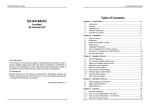
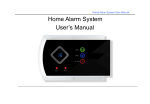

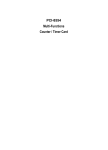
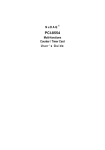
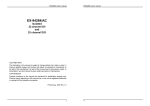

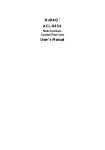

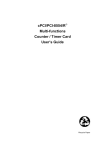
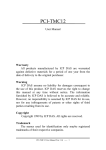
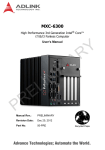
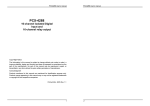
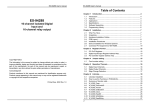
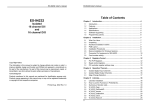
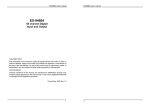
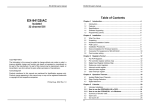
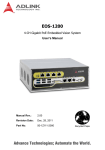
![Télécharger Pdf [2 700 Ko] - Groupement pour l`Amélioration de l](http://vs1.manualzilla.com/store/data/006468132_1-f9b1f24d8f5ebfc71b4689acb6a54463-150x150.png)

